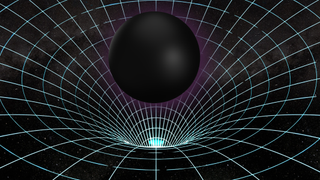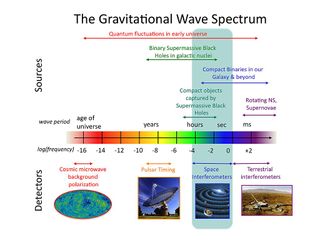Small black holes could play ‘hide-and-seek’ with invisible pairs of black holes
Binary black hole pairings can be used by astronomers in a cosmic game of “hide-and-seek” to hunt for larger, but more elusive, supermassive black hole binaries. Therefore, this method can help solve the mystery of how fast supermassive black holes grew in the early universe.
Finding black holes is no easy task despite their reputation as the fearsome titans of the universe. All black holes are surrounded by a one-way boundary that attracts light called the “event horizon” which ensures that they do not emit light. Even supermassive black holes in the hearts of galaxies with masses of millions or billions of times that of the sun are only “visible” if they eat a lot of material around them or tear apart the unfortunate star.
However, light, or “electrical radiation” as it is properly known, is only one type of radiation. One is “gravitational radiation,” which comes in the form of small waves that make up the sound of the atmosphere called “gravitational waves,” which humans are beginning to detect. That means that instead of looking for supermassive pairs of black holes in this game of hide and seek, astronomers can listen to them.

“Our idea actually works like listening to a radio channel. We propose to use a signal from small black pairs similar to how radio waves carry a signal said, “team leader Jakob Stegmann, a postdoctoral researcher at the Max Planck Institute for Astrophysics. , said in a statement. “Big black holes are music embedded in the frequency modulation (FM) of the received signal.”
Related: Cheating! Some black holes may orbit in egg-shaped orbits
A tiny black hole sings soprano
Gravitational waves are a concept first proposed by Albert Einstein in general relativity, his 1915 magnum opus of gravity.
General relativity suggests that gravity arises when a mass-bearing object “twists” the same fabric of space and time, which Einstein once unified as a four-dimensional entity ( three dimensions of space, one dimension of time) called “space.”
The greater the mass, the greater the surface area of the material being formed. This explains why planets have a greater gravitational pull than moons, why stars have a greater pull than planets, and why holes black has the greatest influence of any one thing.

Einstein also predicted that when things accelerate in space, they cause its fabric to “cry” with waves or gravitational waves. These are completely useless for low-mass objects, but when black holes rotate (remembering that circular motion is acceleration), there is enough mass to generate waves of the importance of attraction.
As these black holes rotate, they emit continuous low-frequency gravitational waves. These gravitational waves remove the angular (or spin) momentum, forcing the black holes together, a process called “stimulation.” This increases the speed of the gravitational waves, thus causing the angular momentum to be picked up faster and faster.
That is until the black holes eventually collide and merge, an event that sends out a loud “scream” of gravitational waves.

However, Einstein predicted that these cosmic waves would be too weak to be detected, mainly because they would lose energy as they propagated through the universe and collided with each other. when black holes occur millions or billions of light years away.
Fortunately, we now know that Einstein was wrong.
Since the detection of the first gravitational wave by the Laser Interferometer Gravitational-Wave Observatory (LIGO) in 2015, which initiated the merger of the 1.3 billion-year-old black hole, many such collisions have been discovered of black holes.
But these studies have one thing in common. When they included black holes, they were always two in a star’s black hole, and their masses are three to a few hundred times that of the sun. Massive gatherings of black holes have been difficult for global gravitational wave instruments such as LIGO and its compatriots VIRGO in Italy and the Kamioka Gravitational Wave Detector (KAGRA) in Japan.

Just as our ears have evolved to hear certain sound waves and not others, these instruments can only detect a certain range of magnetic waves. Gravitational waves produced by spinning pairs of supermassive black holes have frequencies too low to be “heard.”
In other words, in their gravitational waves, binary stars sing soprano, while superclusters sing baritone.
The team proposes to detect subtle changes in the gravitational waves from stellar-mass black hole binaries caused by interference with the gravitational waves from supermassive binaries.
Therefore, these tiny renderings could help reveal the merging of supermassive black holes that are currently only visible as a “background hum” using a large collection of rapidly rotating stars called a “pulsar timing array.”
“The new part of this idea is to use high frequencies that are easy to detect to investigate low frequencies that we don’t understand yet,” said Stegmann.
This proposal may also help to facilitate the design of future magnetic wave instruments, such as NASA and the European Space Agency (ESA) based on the LISA (Laser Interferometer Space Antenna) space.
“When LISA’s path is set, after being accepted by ESA last January, the public needs to evaluate the best strategy for the next generation of magnetic wave instruments,” team member and academician of the “black hole” of the University of Zurich Lucio Mayer said. “In particular, what kind of frequencies should they focus on – studies like this bring a strong impetus to put deci-Hz first. [low-frequency] detector design.”
The team’s research was published Monday (August 5) in the journal Nature.
#Small #black #holes #play #hideandseek #invisible #pairs #black #holes